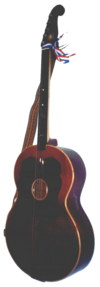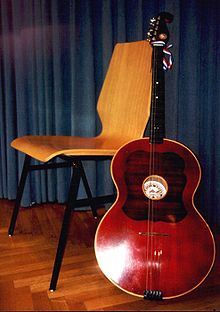Bugarija
The Bugarija [ ˈbuɡariːa ], also Kontra , is a plucked box- neck lute and part of the South Slavic folk instrument group tamburica . The Bugarija is very similar to the guitar in form and function , but in contrast to the guitar it only has three (in the three-part system) or four strings (in the " Srijemer " way). The bugarija is a typical accompaniment and rhythm instrument , which in the tamburica ensemble is mainly the berdaopposite, that is, "contra", which is where the second name for the Bugarija comes from. It is also the only instrument in the tamburica ensemble that plays chords . In contrast to the guitar, the sound is a bit higher and harder. These days there are very few Bugarija players left.
construction
Dimensions
The total length is 1020-1040 mm. The length of the resonance body is 466–490 mm. At its widest point, the sound box is 350–384 mm wide and a total of 83–86 mm high.
Basic form
The bugarija consists of three parts: the body , the neck and the head.
- The body , also called the resonance body , is the hollow part of the bugarija, which is used for resonance and thus also to amplify the otherwise too weak sound of the vibrating string. In terms of shape, the body of the bugarija resembles the guitar. The wood for the body is not made of one piece, but put together and glued. Reasons for this are generally the better volume and the numerous possibilities with the choice of wood to influence the timbre.
- The neck is a narrow and long part that connects the body to the head. On the flat front side are the frets , small metal sticks that change the pitch when you press the strings when you strike them.
- The head was once pointed in shape, which can still be found on some Bisernicas , but the rounded snail-shaped head has generally prevailed. The vertebrae are on the head . Depending on the model, these can be inserted directly into the wood of the head or attached to a metal tuning mechanism.
material
The bugarija is often made from maple , ash or willow . The top of the resonance body on which the resonance hole is located is a thin wooden plate made of spruce or fir wood . The thin layer of wood around the resonance hole, which protects the body from scratches, is made of walnut or ebony .
Mood
The Bugarija comes in three voices : I., II. And III. Bugarija. Depending on the tuning system used by the tamburica ensemble, each of these three is tuned differently. Usually one uses either only the II. Bugarija (with three-part tambura instruments) or only the III. Bugarija (when voting the "Srijemer" way). The I. Bugarija is used less and less.
Three-part system
In the three-part system the three-string bugarijas are tuned as follows:
- The Bugarija I. on the notes B, D and G
- The Bugarija II. On the notes G, B and D
- The Bugarija III. on the notes FIS, A and D
"Srijemer" Art
In a "Srijemer" way the four-string bugarijas are tuned as follows:
- The Bugarija I. on the notes G, B, D and G
- The Bugarija II. On the notes D, G, B and D
- The Bugarija III. on the tones D, FIS, A and D, or in the E system E, GIS, H, E
Some Bugarijas also have a double first string (the thinnest), as some musicians claim that this is how the higher notes sound better.
Playing technique
The bugarija can be played in two ways. A distinction is only made between the type of stroke of the right hand. With the fingers of the left hand one grips certain string combinations on the fingerboard in both cases in order to get different triads or chords (the most common ones would be major , minor and seventh chords ) with one hit of the right hand over all strings :
Beat
All strings are struck at once with the pick or thumb from top to bottom, exclusively from the wrist (and not from the elbow like the guitar), in order to make the chord played by the left hand sound. So mostly short notes ( eighth notes , sixteenth notes , etc.) are played, but also those that are marked as staccato . The pick is used by default, but you usually hit the thumb when you want a quieter, softer and warmer sound.
tremolo
An alternating strumming technique in which the strings are struck repeatedly with the plectrum in order to give the impression of a continuous tone. The faster and closer the tremolo is played, the sooner this effect will be achieved. As a rule, longer notes ( quarter notes , half notes , and whole notes ) are played, but also those marked as legato . With this playing technique, too, only the fist of the right hand is moved and not the entire forearm.
notation
There is no strict way of noting compositions and scores for the Bugarija.
In the simplest and most primitive case, the chord to be played can only be identified with a single note, with a certain symbol above each note, which adds the missing chord information to the respective note: for example, if the respective note represents the note A and above a small cross (+) is noted, then an A minor chord is to be played here. A small circle (°) means A major, a small 7 means that the A major seventh chord must be played (in the case of a minor seventh chord there is a small cross in front of the 7, i.e. + 7). Using the same principle, the major sixth chord is notated with a 6 (the minor sixth chord with +6) and a diminished chord with dim (from diminished). The most important ones are hereby named.
In official tamburica orchestral scores, however, all chords are classically marked by four notes with the associated accidentals : each note here stands for one of the 4 strings on the bugarija.
Function in the tamburica ensemble
The bugarija belongs to the rhythm section of a tamburica ensemble. In interaction with the Berda, the Bugarija gives rhythm and harmony to the respective composition : The Berda sounds on the first and third beats in time and the Bugarija on the second and fourth (i.e. on the unstressed beats). This provides the rhythmic basis on which the entire melody , which is carried by the other (melodic) tamburica instruments, is built. In very rare cases the bugarija also plays melodic lines. But often these are the melodies of Brač III.
Manufacturer
In the former Yugoslavian territory, the best quality E-Bugarijas (Bugarijas tuned in the E-System as standard) were produced in Vojvodina by the following Tamburica farmers: Master Bocan, Kudlik, Torma and Vidaković, and in Croatia by Master Rorbacher and Bošnjaković.
The currently best tamburica builders in Croatia are Master Stevan Tatić from Osijek , Master Đuro Zarić from Vinkovci , Master Drago Knobloch from Orahovica and, last but not least, Master Rajković from Srijemska Mitrovica .
The best D-Bugarijas are made by Master Žmegač in Varaždin , Master Gilga in Sisak and Master Katulić from Buševac near Velika Gorica .
See also
literature
- Josip Andrić: Škola za Tambure . 1953 ("School of Tambura Instruments")
Web links
- http://www.tresnjevka.net/tambura.htm
- http://www.svita.net/instrumenti.htm#kontra
- http://home.pages.at/tamb/hrvatski/instrumenti.htm#nazivi
- Tambura ( Memento from February 28, 2008 in the Internet Archive )
Individual evidence
- ↑ See http://www.tamburica.net/instrumenti/zice.asp ( Memento from March 25, 2010 in the Internet Archive ) . As of November 15, 2008.


